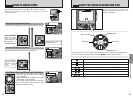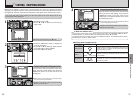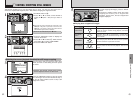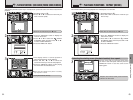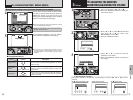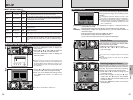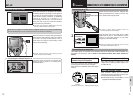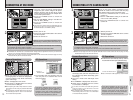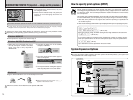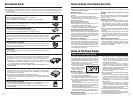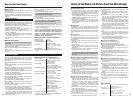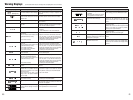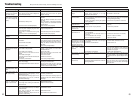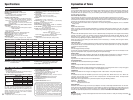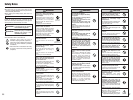
7978
Notes on the Media (xD-Picture Card and Microdrives)
■ Image Memory Card
h This Image Memory Card is a new image recording
media (xD-Picture Card) developed for digital
cameras. The Image Memory Card consists of a
semiconductor memory (NAND-type flash memory) to
record digital image data.
The recording process is electrically performed and
enables erasure of existing image data as well as re-
recording of new image data.
h When using a new Memory Card, or a Memory Card
that has been initialized by a PC, be sure to initialize
(format/initialize) the card with your digital camera
before using it.
■ Microdrives
Microdrives are compact, lightweight hard disk drives
that conform to the CF+ Type II standard. Due to their
ample capacity for large image data files and their low
per-megabyte recording cost, Microdrives provide a
more economical way to save high-resolution image
files.
■ Storing Data
In the situations listed below, recorded data may be
erased (destroyed). Please note that FUJIFILM accepts
no responsibility whatsoever for the loss (destruction) of
recorded data.
✽ When the media is used incorrectly by the owner or a
third party
✽ When the media is exposed to static electricity or
electrical noise
✽ When the media is removed or the camera is
switched off during data recording or erasing (media
formatting)
✽ When the media is bent, dropped or otherwise
subjected to a strong force or impact
You should always back up important files onto
another media (MO disk, CD-R, CD-RW, hard
disk, etc.).
■ General Notes on Handling Media (all types)
h When inserting the media into the camera, hold the
media straight as you push it in.
h Never remove the media or switch the camera off
during data recording or erasing (media formatting) as
this could result in damage to the media.
h Data storage media are precision electronic devices.
Do not bend, drop or otherwise subject the media to
strong force or shocks.
h Do not use or store these media in environments
likely to be affected by strong static electricity or
electrical noise.
h Do not use or store media in locations subject to high
temperatures and humidity or in environments where
they are exposed to corrosive substances.
■ Notes on Handling xD-Picture Card
h Keep xD-Picture Cards out of the reach of small
children. When storing xD-Picture Cards, ensure that
they are kept in a location out of the reach of small
children to prevent a card being accidentally
swallowed. An xD-Picture Card could cause
suffocation if accidentally swallowed. If a child
swallows an xD-Picture Card, seek medical advice
immediately.
h Make sure that the memory card is straight when you
insert into the camera etc.
h The memory card is a precision electronic instrument.
Do not apply pressure or shock, and avoid bending.
h Do not use the memory card in a hot, humid, or
corrosive environment.
h If the contact area on the card is soiled (dust,
fingerprints, etc.), wipe it clean with a soft, dry cloth.
h Clean the memory card with a soft dry piece of cloth
when dirty.
h When you carry or store it, always keep the card in
the anti-static case provided. Use a storage case if
available.
h The memory card can be used reliably for a long
period of time, but will eventually lose its ability to
store and play back image data. At this point, replace
with a new memory card.
h Never remove the xD-Picture Card or switch the
camera off during data recording, during data erasing
(xD-Picture Card formatting) or during frame advance
when images are being played back. These actions
could result in damage to the xD-Picture Card.
h The use of xD-Picture Cards is recommended with
the FinePix M603.
The camera quality cannot be guaranteed when cards
other than those manufactured by FUJIFILM are
used.
h The xD-Picture Card may feel warm when it is
removed from the camera after extended periods of
picture taking or image viewing. This is normal and
does not indicate a fault.
h Do not affix labels to the xD-Picture Card.
This could result in the label peeling off and causing a
fault when the card is inserted or removed.
■ Notes on using Microdrive
h Do not write on the Microdrive label.
h Do not peel off the Microdrive label.
h Do not stick additional labels onto a Microdrive.
h When carrying or storing a Microdrive, keep it in the
protective case provided.
h Do not use Microdrive in CF+ Type II slots that do not
have an eject function.
h Take care when handling Microdrive that have been
used for long periods as they may become hot.
h Do not place Microdrive close to strong magnetic
fields.
h Keep Microdrive dry.
h Do not apply strong pressure to the Microdrive cover.
■ Notes on using media with a computer
h If you intend to take photos using a media that has
been used on a personal computer, format the media
on your camera.
h When you format a media in the camera and then
shoot and record images, a directory (folder) is
automatically created. Image data is then recorded in
this directory.
h Do not change or delete the directory (folder) names
or file names on the media from your computer as this
will make it impossible to use the media in your
camera.
h Always use the camera to erase image data on a
media.
h To edit image data, copy the image data to the
computer’s hard disk and then edit the copied data.
h Do not copy files other than those that will be used by
the camera.
■ Specifications
Type Image memory card for digital cameras
(xD-Picture Card)
Memory type NAND-type flash memory
Conditions for use Temperature:
0°C to +40°C (+32°F to +104°F)
Humidity:
80% max. (no condensation)
Dimensions 25 mm × 20 mm × 2.2 mm
(0.98 in. × 0.79 in. × 0.09 in.) (W × H × D)
Notes on the Power Supply
■ Battery Life
At normal temperatures, the NP-60 can be used at
least 300 times.
If the time for which the NP-60 provides power
shortens markedly, this indicates that the NP-60 has
reached the end of its effective life and should be
replaced.
Lithium-ion Battery Pack NP-60 is both compact and
capable of storing large quantities of power. However,
if it is stored for long periods while charged, the
performance of the battery can be impaired.
h If the battery will not be used for some time, run
the battery flat before storing it.
h Always remove the battery from the camera or
battery charger when it is not being used.
h Place the battery pack inside the soft case and
store in a cool place.
✽The battery should be stored in a dry location with
an ambient temperature between +15°C and
+25°C (+59°F and +77°F).
✽Do not leave the battery in hot or extremely cold
places.
■ Handling the Battery
To avoid injury or damage, observe the
following:
h Do not allow the metal portions of the battery to
touch other metal objects.
h Do not bring the battery close to a flame or throw
it into a fire.
h Do not attempt to disassemble or modify the
battery.
h Do not recharge the battery with chargers other
those specified.
h Dispose of used batteries promptly.
To avoid damaging the battery or shortening
its life, observe the following:
h Do not drop the battery or otherwise subject it to
strong impacts.
h Do not immerse the battery in water.
To ensure that you obtain optimum battery
performance, observe the following:
h Always keep the battery terminals clean.
h Store the battery in a cool, dry place. Storing the
battery for long periods in a hot location can
shorten the battery life.
If you use the battery for a long period, the
camera body and the battery itself will become
warm. This is normal and is not a malfunction.
Use the AC power adapter supplied with the
camera if you are taking pictures or viewing
images for a long period of time.
■ Specifications of the Enclosed NP-60
Nominal voltage DC 3.7V
Nominal capacity 1035mAh
Operating temperature
0°C to +40°C
(+32°F to +104°F)
Dimensions 35.2 mm × 53 mm × 7.0 mm
(1.39 in. × 2.1 in. × 0.28 in.)
(W × H × D)
Mass (Weight) Approx. 30g (1.05 oz.)
✽ These specifications are subject to change without
notice.
Notes on storage
Use only the AC-5VS/AC-5VHS AC Power Adapter
with your FinePix M603 Digital Camera. The use of
other AC power adapters may result in damage to
your camera.
hThe AC Power Adapter is only intended for indoor
use.
hPush the connection cord plug firmly into the DC
input socket.
hWhen unplugging the connector cord, switch the
camera off and pull out the plug by grasping the
plug itself. (Do not pull on the cord.)
hDo not use the AC power adapter with any device
except the specified device.
hDuring use, the AC power adapter will become
hot to touch, but this is normal.
hDo not disassemble the AC power adapter. Doing
so could be dangerous.
hDo not use the AC power adapter in a place with
high temperature and high humidity.
hDo not drop or subject the AC power adapter to
strong shocks.
hThe AC power adapter may emit a humming
noise, but this is normal.
hIf used near a radio, the AC power adapter may
cause static, so play the radio in a distant place.
✽Very occasionally, DC output will be prevented by
the operation of the internal protection circuit. In
this event, unplug the AC-5VS/AC-5VHS AC
power adapter from the power socket for a few
moments and then plug it in again. This will
restore DC output.
■ Specifications (AC-5VS/AC-5VHS)
Power Supply AC 100V to 240V, 50/60Hz
Rated Input Capacity 12W (U.S.A. and Canada)
0.15A to 0.24A
(other countries)
Rated Output DC 5.0V 1.5A
(U.S.A. and Canada)
DC 5.0V 2.0A (other countries)
Temperature During Use
0°C to +40°C (+32°F to +104°F)
(U.S.A. and Canada)
0°C to +45°C (other countries)
Storage Temperature -10°C to +70°C
(+14°F to +158°F)
Dimensions (MAX.) 47 mm × 20 mm × 72 mm
(1.9 in. × 0.8 in. × 2.8 in.)
(W × H × D)
(U.S.A. and Canada)
49 mm × 40 mm × 65 mm
(W × H × D) (U.K.)
49 mm × 31 mm × 65 mm
(W × H × D)
(other countries)
Mass (Weight) Approx. 120 g (4.2 oz.)
(U.S.A. and Canada)
Approx. 200 g (7.0 oz.) (U.K.)
Approx. 180 g (6.4 oz.)
(other countries)
Connection Cord Length
Approx. 2 m (6.6 ft.)
✽Please note that specifications and characteristics are
subject to change without notice.
AC Power Adapter



